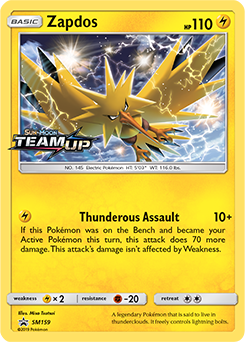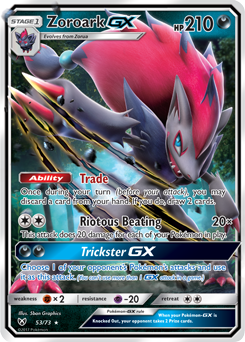Zapdos at the EUIC and in the Unbroken Bonds Meta
Guten Tag, meine Freunde! Unbroken Bonds had finally arrived, and there is plenty of buzz and excitement about all of the new deck possibilities that have arrived with it. For those of us here in Europe however, one last tournament remains for the Team Up era. The OCIC brought us into this format, and so it is fitting that the EUIC will close it out!

Throughout this quarter, I’ve been rather adamant about the strength of Zapdos (with Jolteon-GX in particular). Shortly after Team Up was released, I declared Zapdos to be the BDIF. Looking back now that the quarter is nearing its end, I believe that declaration to have been accurate. Zapdos started things off by winning the OCIC and has been the most dominant deck in terms of Regional & SPE Top 8 finishes by a solid margin (with 32 Top 8s in 14 events – a number which jumps even higher if you count the Pikachu and Zekrom-GX / Zapdos decks). This is almost 40% more finishes than the next closest deck (Zoroark-GX with 23)! Personally, this is the first quarter in recent memory that I’ve stuck with a single deck the entire time. Normally, I switch decks fairly often, as I jump from concept to concept; however, for this quarter, I’ve been impressed enough by the strength of Zapdos and the lack of widespread counters to the deck that I’ve felt no need to switch. Fittingly, as I began the Team Up quarter writing about Zapdos, I’ll be ending it by writing about it again. For this article, I’ll first take a look at the deck’s dominance during this last quarter, and why I expect it to perform well at the EUIC in the same way it did at the OCIC. After that, I’ll go beyond Team Up, and take a look forward into the deck’s place in the future meta of Unbroken Bonds.
First, an important question: why is Zapdos still good going into Berlin?
Zapdos at the EUIC
A Helpful Pattern
Thus far, the US results have followed somewhat of a pattern: the deck that beats the deck that beats the deck that won the last tournament will win the next one. At the OCIC, Zapdos won and was then seen as the dominant deck. Then, in Collinsville, Zoroark-GX decks were the most played, possibly due to their strong Zapdos matchup. The winning deck then ended up being something not with a strong Zapdos matchup, but one with a strong Zoroark matchup: Blacephalon-GX / Naganadel. In Denver, Zapdos decks were the most popular deck again, possibly due to its strong Blacephalon matchup – and then Zapdos counters dominated the Top 8. If that reactionary pattern continues, one would expect to see a lot of play from decks which counter ZoroControl, Regigigas, and Celebi and Venusaur-GX, followed by a win from a deck with a strong matchup against those counter decks. The two decks that best fit that “counter deck” profile are Blacephalon-GX and Malamar – both of which are excellent matchups for Zapdos!
If the pattern does indeed hold true, then Zapdos is a great pick for the EUIC. If players gravitate toward the successful anti-Zapdos decks from Denver, then the early rounds will be a minefield for any Zapdos player. If they avoid those poor matchups in the early rounds, however, then the later rounds should be full of positive matchups, such as Blacephalon and Malamar. If players overpredict the prevalence of the anti-Zapdos decks, then the early field will be even better. Zapdos also has an advantage as one of the format’s strongest decks, so I would consider it to be a rather safe play overall. Even if anti-Zapdos decks are indeed popular, they won’t make up more than a third of the field; they didn’t accomplsh this in either Collinsville or Denver, even after Zapdos’s OCIC success. Even at that number, that still leaves six rounds of even-to-positive matchups for Zapdos, more than enough to get some Championship Points. With a bit of luck, that kind of a field is more than ripe for a Zapdos player to make a deep run into day two and beyond.
Pattern Rationale
Now, it is worth noting that this “pattern” isn’t a hard rule, but rather, a consequence that has manifested itself as a result of a diverse Tier 1 with no clear agreed upon BDIF, as well as natural meta cyclicality. As far as the Tier 1 matchups go, most haven’t changed all that much since the OCIC.

Whenever a deck wins a major tournament like a US Regionals, it makes sense that players will gravitate toward a deck with a good matchup against that winning deck – after all, why would you want to play something that loses to the deck that won? However, since the current format has been rather evenly matched, such a strategy hasn’t been a successful one. Simply winning a major event hasn’t caused a deck to increase in popularity, and the format has been varied enough that simply having a strong matchup against the “deck to beat” isn’t enough to achieve tournament success. So, the number of counter decks increase, but the numbers of the decks that they are countering do not. This makes things more dangerous for players who have decided to stick with the winning deck, but doesn’t necessarily make things easier for those who have tried to counter it. Likewise, for players using decks which are strong against those counter decks, but weaker against the winning deck, the number of positive matchups they have increase. As the tournament reaches its later stages, we get the following result:
- The winning deck struggles early, against the increased number of counter decks
- The counter decks initially succeed, but then struggle against the wider field, since they aren’t as strong into a generic matchup
- Decks strong against the counter decks then have strong matchups against the Day Two field, if they’ve made it that far
Applying this logic to Denver’s Top 8 results, I would not at all be surprised if people jumped away from Zapdos as a deck. Between the two Regigigas, the Celebi & Venusaur, and the winning ZoroControl deck, it would be easy to come to the impression that the field was a terrible one for Zapdos. In the most recent major European event (SPE Bolanzo), the Top 8 was mixed; four of the decks appeared to be matchups unfavorable for Zapdos, but the three Zapdos decks also ended up being three of the Top 4 decks (including the winning deck). I wouldn’t, however, expect many players to change over to the various Control decks that did well. Control, as an archetype, seems to be naturally unpalatable for quite a few players to pilot, more so than other decks. My expected field would thus include an increased number of anti-Control decks such as Blacephalon-GX and Malamar, without a huge increase in the number of Control decks. While the strong matchups for those decks might not increase, if Zapdos does indeed see a drop in play, then the field will still be better for those anti-Control decks. For a deck like Zapdos, the number of positive matchups will also then increase. Therefore, if a Zapdos player can avoid the Control decks in the early rounds, the rest of the tournament will likely go well.
This concludes the public portion of this article.
If you'd like to continue reading, consider purchasing a PokeBeach premium membership! If you're not completely satisfied with your membership, you can request a full refund within 30 days.
Each week we post high-quality content from some of the game's top players. Our article program isn't a corporate operation, advertising front, or for-profit business. We set our prices so that we can pay the game's top players to write the best content for our subscribers. Each article topic is carefully selected, goes through multiple drafts, and is touched up by our editors. We take great pride in our program!

